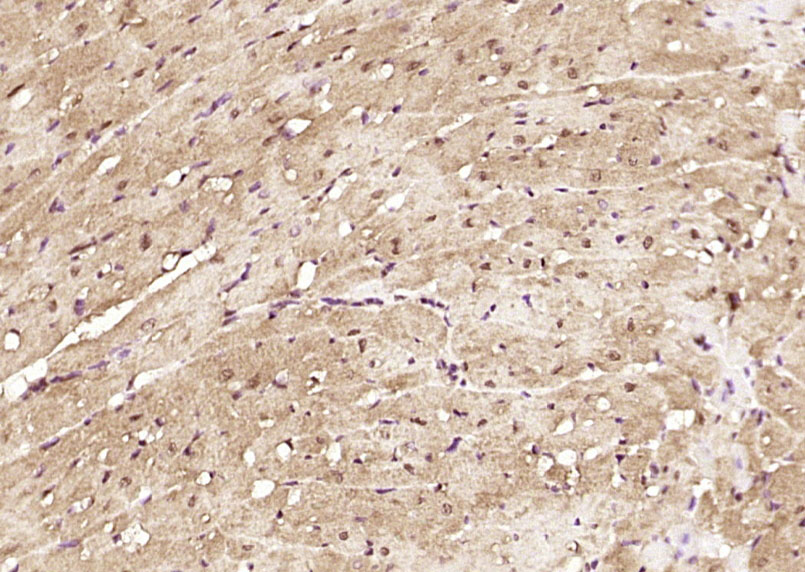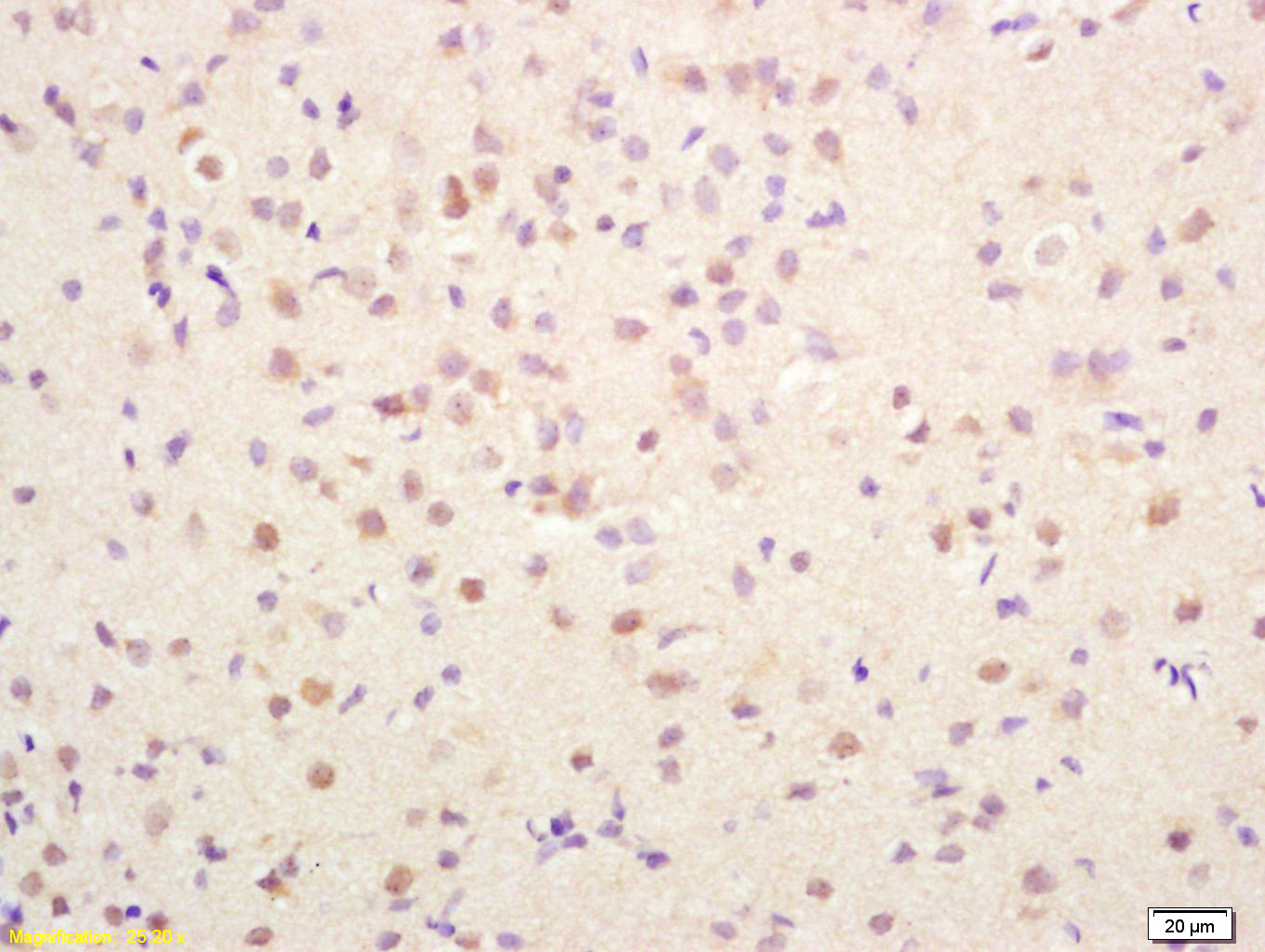
Rabbit Anti-PRKAG2 antibody
5''-AMP-activated protein kinase subunit gamma-2; AAKG; AAKG2; AAKG2_HUMAN; AMPK gamma2; AMPKgamma2; AMPK subunit gamma 2; AMPK subunit gamma-2; CMH6; H91620p; Prkag2; Protein kinase AMP activated gamma 2 non catalytic subunit; WPWS.AMPKγ2; AMPK γ2; AMPK
View History [Clear]
Details
Product Name PRKAG2 Chinese Name 腺苷单磷酸活化蛋白激酶γ2抗体 Alias 5''-AMP-activated protein kinase subunit gamma-2; AAKG; AAKG2; AAKG2_HUMAN; AMPK gamma2; AMPKgamma2; AMPK subunit gamma 2; AMPK subunit gamma-2; CMH6; H91620p; Prkag2; Protein kinase AMP activated gamma 2 non catalytic subunit; WPWS. AMPKγ2; AMPK γ2; AMPK γ 2; AMPK-γ2; AMPKγ-2; AMPK-γ-2; Research Area Tumour Cardiovascular Cell biology Signal transduction Immunogen Species Rabbit Clonality Polyclonal React Species Rat, (predicted: Human, Mouse, Chicken, Dog, Pig, Cow, Horse, ) Applications WB=1:500-2000 ELISA=1:5000-10000 IHC-P=1:100-500 IHC-F=1:100-500 ICC=1:100-500 IF=1:50-200 (Paraffin sections need antigen repair)
not yet tested in other applications.
optimal dilutions/concentrations should be determined by the end user.Theoretical molecular weight 63kDa Cellular localization The nucleus cytoplasmic Form Liquid Concentration 1mg/ml immunogen KLH conjugated synthetic peptide derived from human PRKAG2: 265-370/569 Lsotype IgG Purification affinity purified by Protein A Buffer Solution 0.01M TBS(pH7.4) with 1% BSA, 0.03% Proclin300 and 50% Glycerol. Storage Shipped at 4℃. Store at -20 °C for one year. Avoid repeated freeze/thaw cycles. Attention This product as supplied is intended for research use only, not for use in human, therapeutic or diagnostic applications. PubMed PubMed Product Detail AMPK is a heterotrimeric complex comprising a catalytic a subunit and regulatory b and g subunits. It protects cells from stresses that cause ATP depletion by switching off ATP-consuming biosynthetic pathways. AMPK is activated by high AMP and low ATP through a mechanism involving allosteric regulation, promotion of phosphorylation by an upstream protein kinase known as AMPK kinase and inhibition of dephosphorylation. Activated AMPK can phosphorylate and regulate in vivo hydroxy-methylglutaryl-CoA reductase and acetyl-CoA carboxylase, which are key regulatory enzymes of sterol synthesis and fatty acid synthesis, respectively. The human AMPKa1 and AMPKa2 genes encode 548 amino acid and 552 amino acid proteins, respectively. Human AMPKb1 encodes a 271 amino acid protein and human AMPKb2 encodes a 272 amino acid protein. The human AMPKg1 gene encodes a 331 amino acid protein. Human AMPKg2 and AMPKg3, which are 569 and 492 amino acid proteins, respectively, contain unique N-terminal domains and may participate directly in the binding of AMP within the AMPK complex.
Function:
AMP/ATP-binding subunit of AMP-activated protein kinase (AMPK), an energy sensor protein kinase that plays a key role in regulating cellular energy metabolism. In response to reduction of intracellular ATP levels, AMPK activates energy-producing pathways and inhibits energy-consuming processes: inhibits protein, carbohydrate and lipid biosynthesis, as well as cell growth and proliferation. AMPK acts via direct phosphorylation of metabolic enzymes, and by longer-term effects via phosphorylation of transcription regulators. Also acts as a regulator of cellular polarity by remodeling the actin cytoskeleton; probably by indirectly activating myosin. Gamma non-catalytic subunit mediates binding to AMP, ADP and ATP, leading to activate or inhibit AMPK: AMP-binding results in allosteric activation of alpha catalytic subunit (PRKAA1 or PRKAA2) both by inducing phosphorylation and preventing dephosphorylation of catalytic subunits. ADP also stimulates phosphorylation, without stimulating already phosphorylated catalytic subunit. ATP promotes dephosphorylation of catalytic subunit, rendering the AMPK enzyme inactive.
Subunit:
AMPK is a heterotrimer of an alpha catalytic subunit (PRKAA1 or PRKAA2), a beta (PRKAB1 or PRKAB2) and a gamma non-catalytic subunits (PRKAG1, PRKAG2 or PRKAG3). Interacts with FNIP1 and FNIP2.
Subcellular Location:
Cytoplasmic and Nuclear
Tissue Specificity:
Isoform B is ubiquitously expressed except in liver and thymus. The highest level is detected in heart with abundant expression in placenta and testis.
Post-translational modifications:
Phosphorylated by ULK1; leading to negatively regulate AMPK activity and suggesting the existence of a regulatory feedback loop between ULK1 and AMPK. Phosphorylated upon DNA damage, probably by ATM or ATR.
DISEASE:
Defects in PRKAG2 are the cause of cardiomyopathy, familial hypertrophic type 6 (CMH6) [MIM:600858]. A hereditary heart disorder characterized by ventricular hypertrophy, which is usually asymmetric and often involves the interventricular septum. The symptoms include dyspnea, syncope, collapse, palpitations, and chest pain. They can be readily provoked by exercise. The disorder has inter- and intrafamilial variability ranging from benign to malignant forms with high risk of cardiac failure and sudden cardiac death. CMH6 patients present Wolff-Parkinson-White ventricular preexcitation, enlarged myocytes without myofiber disarray, and glycogen-containing cytosolic vacuoles within cardiomyocytes.
Defects in PRKAG2 are a cause of glycogen storage disease of heart lethal congenital (GSDH) [MIM:261740]; also known as phosphorylase kinase deficiency of heart or congenital nonlysosomal cardiac glycogenosis. GSDH is a rare disease which leads to death within a few weeks to a few months after birth, through heart failure and respiratory compromise.
Similarity:
Belongs to the 5'-AMP-activated protein kinase gamma subunit family.
Contains 4 CBS domains.
SWISS:
Q9UGJ0
Gene ID:
51422
Database links:
Entrez Gene: 51422 Human
Entrez Gene: 108099 Mouse
Omim: 602743 Human
SwissProt: Q9UGJ0 Human
SwissProt: Q91WG5 Mouse
Unigene: 647072 Human
Unigene: 33649 Mouse
Product Picture
Antigen retrieval: citrate buffer ( 0.01M, pH 6.0 ), Boiling bathing for 15min; Block endogenous peroxidase by 3% Hydrogen peroxide for 30min; Blocking buffer (normal goat serum,C-0005) at 37℃ for 20 min;
Incubation: Anti-PRKAG2/AMPKγ2 Polyclonal Antibody, Unconjugated(SL9446R) 1:200, overnight at 4°C, followed by conjugation to the secondary antibody(SP-0023) and DAB(C-0010) staining
References (0)
No References
Bought notes(bought amounts latest0)
No one bought this product
User Comment(Total0User Comment Num)
- No comment




 +86 571 56623320
+86 571 56623320
 +86 18668110335
+86 18668110335

